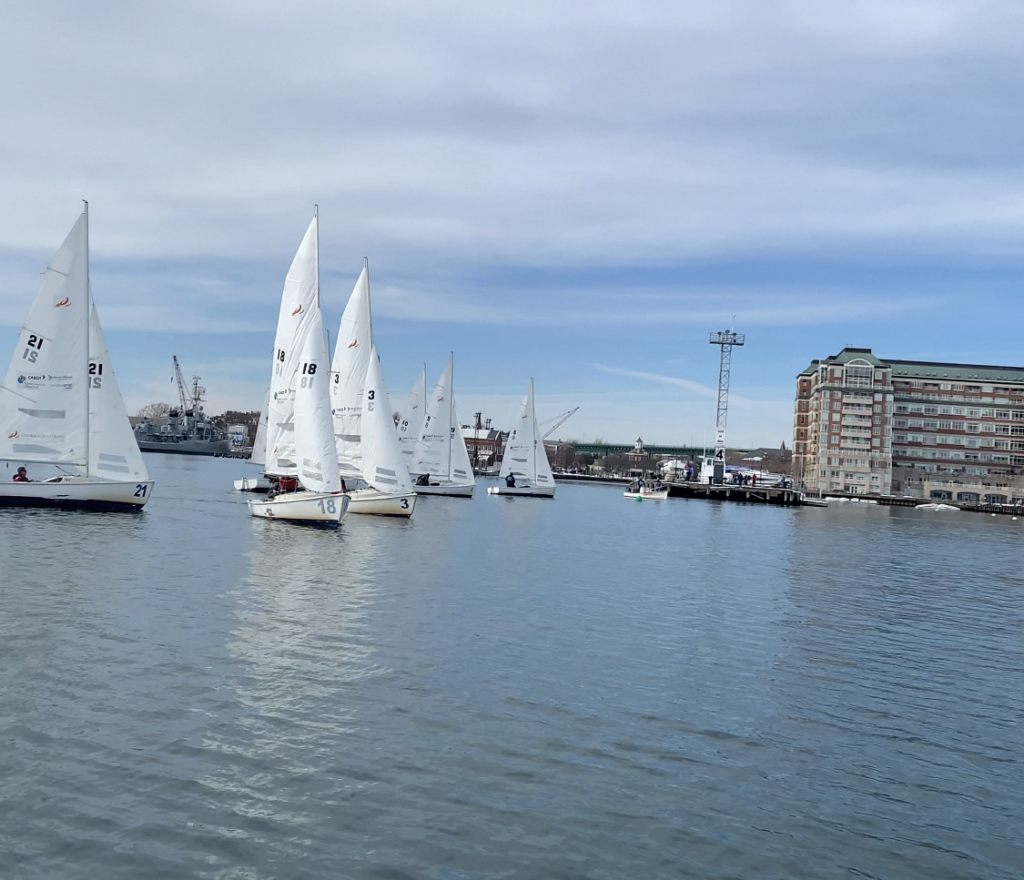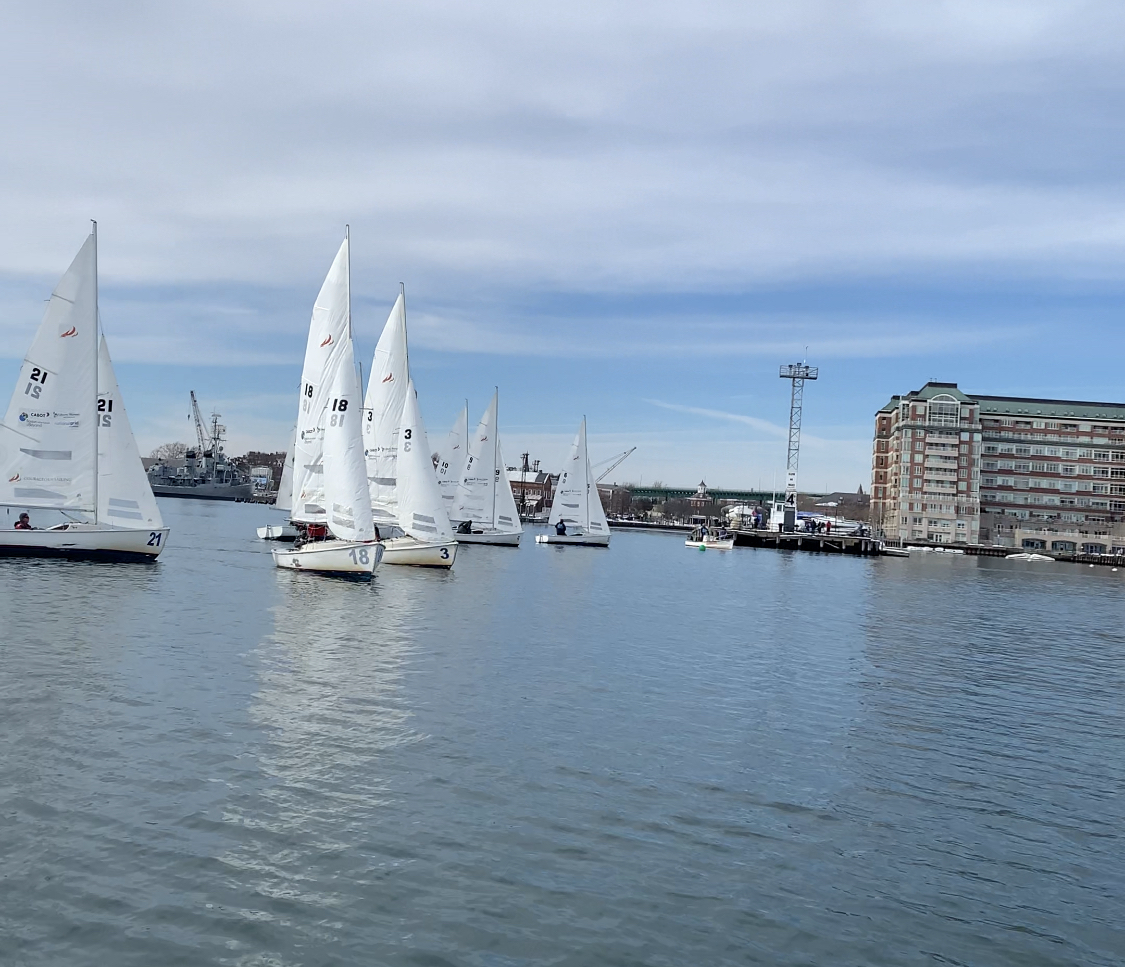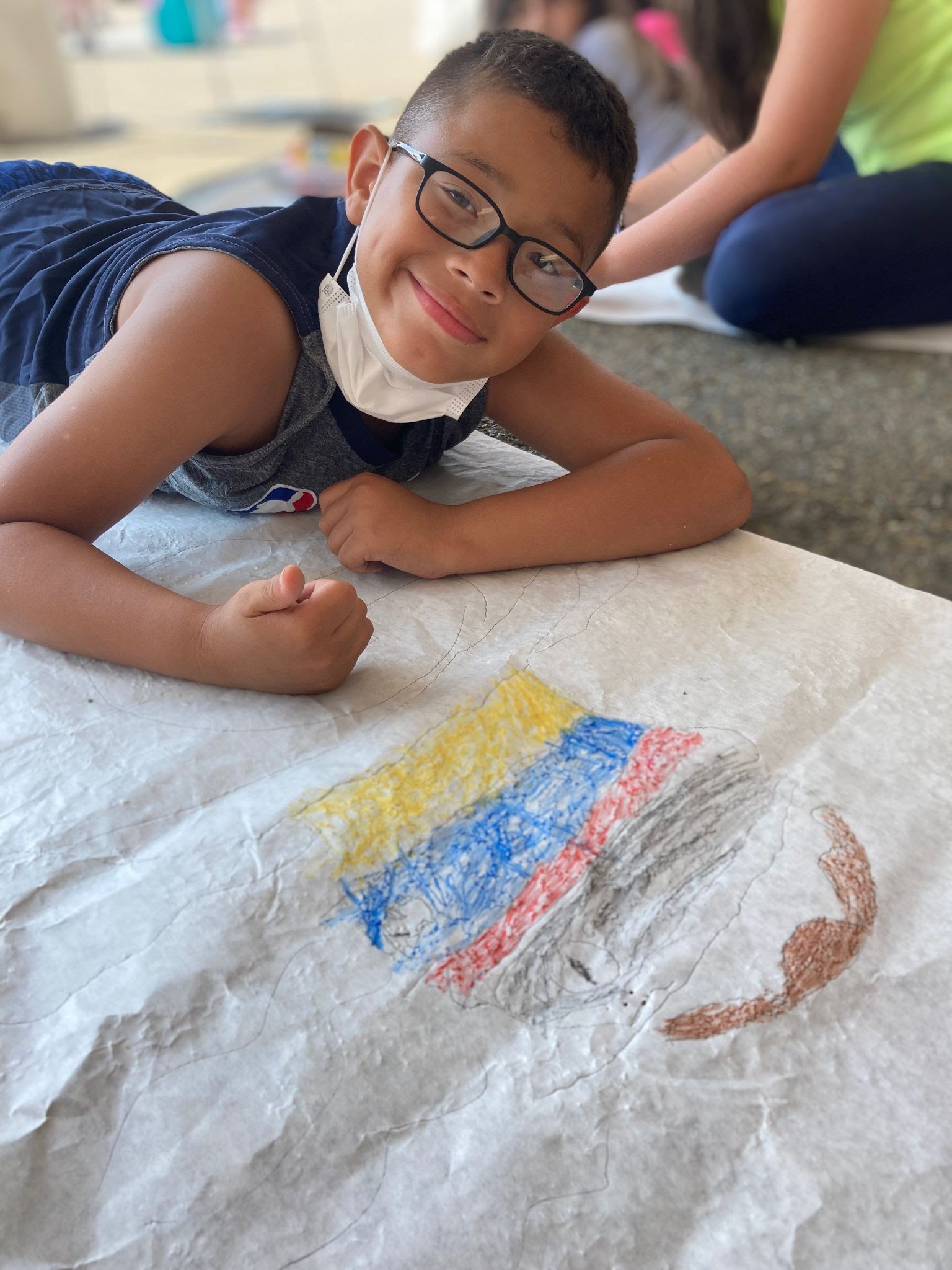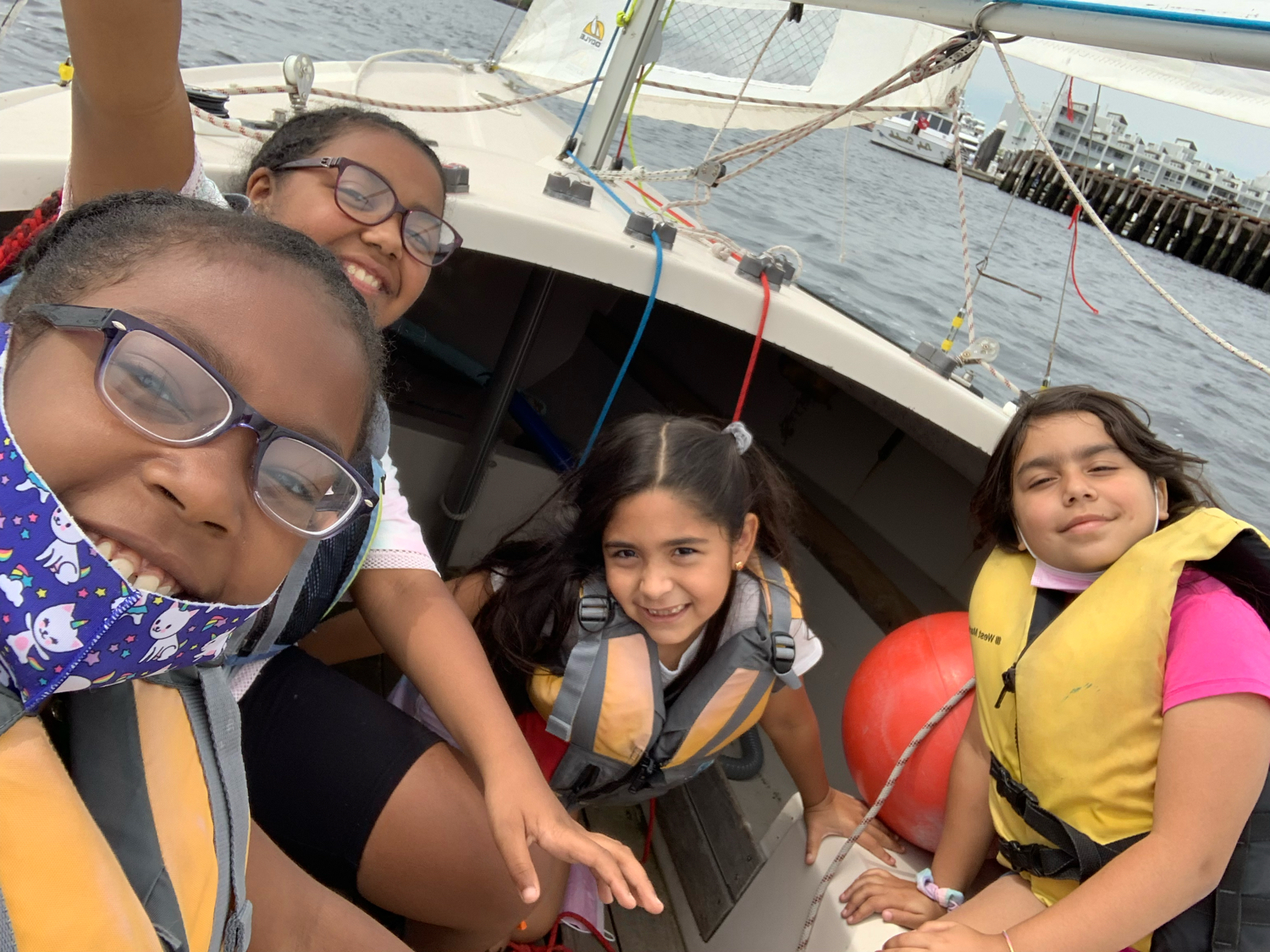Valentine's Day recap- 2020/2021
Hello Frostbiters,
Well it certainly didn't look promising at the start, but by the end of the day we had five great races in the books! After an hour delay due to a complete lack of wind and a tanker we decided to head out. I don't think anyone was super optimistic when we left the dock that anything would materialize. But it was mostly sunny and it felt relatively warm (despite being 28 degrees), so we figured we would float for a while and maybe sneak in a race or two.
We had a full fleet again this past week, which is always great to see. After sitting out there for about 20-30 minutes, we noticed a slight breeze building from the Tobin Bridge, and coming down the Mystic River. A quick scan of the harbor confirmed that this was, in fact, the only wind anywhere to be found in the inner harbor. As the wind started to fill in, it was very apparent that there were going to be lots of shifts all day long. Luckily the shifts all stayed within a particular range that allowed us to set up a course close to our home pier. Usually we avoid racing in this area because if the wind does shift too far right or left, we don't have enough space for the course. But this week it worked out perfectly.
Because the wind was so light, we set a fairly short course with a very tight line. At first it seemed like the course might even be a little too small, but after the first upwind leg it was clear that the course was long enough. Our starting line was set right off Pier 4, with windward marks right in the middle of the channel headed up towards the mystic. The location of the start line made for some great spectating right on the pier.
Also if you haven't already, definitely check out the RaceQ data that Luke posted. You can find it here.
Our first race didn't get started until almost 1:15. The wind was very light at the start and a slight but steady current was running from top to bottom of the course. The start was still fairly aggressive though. Legler/Smith and Veenland-Lee both had great starts at the boat end and were able to get out ahead of most of the fleet. The wind died way down after about 2 or 3 boats had rounded the windward mark. A few boats got stuck in a very big hole right near the Eddy building on the right side. But the wind picked up again as boats were starting to head downwind. Marston/Brand and Legler/Smith reached the gate at about the same time. Marston/Brand took the left gate and managed to edge out Legler/Smith at the finish.
Start of Race 2

Race 2 had very little wind at the start and as a result most boats were pretty far off the line at the start. Boats #18 (Robinson/Pereira) and #3 ("Jumbros" Ansgar and George) were the only ones close up to the line with any speed. They would finish in 2nd and 1st respectively.
Our fantastic front desk manager Maeve was able to capture the first few minutes of the first leg of Race 2 from the end of the pier, and you can really see just how light the wind was. Check it out!
Start of Race 3

The breeze was back up a bit for the start of Race 3, and everyone was up on the line for the start. Before the start of the race we tried to move the pin down slightly, because it appeared at the boat end was slightly favored. However in resetting the pin, the current carried it down a little further than we would have liked. As a result we had a group on the left side of the line that was all OCS with about 10 seconds to go. However most of them were able to quickly head down and duck the line ("I" flag was not up) but boats #2 and #6 were still OCS. At the finish we had an all Tufts top-3, with the bullet going to Ansgar Jordan and George Sidamon-Eristoff. Connor Sheridan and Alessandra Jacimovic sailing for the Winchester Wombats came in 2nd, and coaches Ken Legler and Emmett Smith coming in 3rd.
Start of Race 4

We were able to reset the pin before the start of Race 4 luckily, because the wind started to head more right than it had been all day. Neal Goldman/Dorothy Liftig in boat #7 had a great start at the pin end. Marston/Brand you can see clearly in #11 had a great start in the middle, and not pictured is boat #9 (James Pinder/Ian Taylor) who hit the boat end of the line about 1.5 seconds after this photo. They would round the leewards in first with a 5 boat length lead on Goldman/Liftig. They would finish in 1st, but Legler/Smith and Chris Lombardo/Tom Doak managed to sneak their way in and grab 2nd and 3rd respectively.
Race 5 was our last race of the day. I don't have a clear photo of the start unfortunately, but both Goldman/Liftig and the Jumbros were up on the line for a good start. We only had one boat OCS but they were again able to clear themselves pretty quickly. This was the first day in a long time that I can remember where we didn't have to use the "I" flag once all day. At the leeward rounding Legler/Smith had established a good sized lead with only Goldman/Liftig nearby. But Legler/Smith would not be caught and finish in first place. And the "old guys" proved they could still play and Legler/Smith finished first overall on the day. Congrats! Ken was kind enough to share some of his thoughts on the day. I've included them here...
Saturday de-brief from Feb 13.
Finally won a day in this tough fleet. A few things definitely went in our favor. It was a combination of good luck, good speed, and good moves.
1. Boat and body prep
The amount of snow on deck was more than anticipated but between Emmet and I, we not only got rid of it all in short order, we got warm in the process. I arrived first and got a long-handled scrub brush for brushing off the cover and using the handle to break a good bit of ice underneath the snow on deck. Emmet had a combo ice scraper/brush from the car. The boat was clean once done. It could be much worse. The J-24s at BSC are much harder to de-ice, with all the fitting on deck and no cover. Worse still was the BSC whaler years ago that leaked and would end up with four inches of sea ice on the floor every Saturday. Also worse, when I was frostbiting Lasers in college, I had to dig my spars out from under the snow, then chuck them in the harbor to separate them. Ah, to be young and dumb again, even dumber than I am now.
I dress much differently than when running races proving once again that sailing is much warmer than motorboating. This explains why the water is so flat; no one is out for a pleasure cruise in a power boat unlike in summer. Huge thanks to Nate, Emilio, and the fine staff. I don’t wear foul weather gear, just an old and warm black coat to absorb the sun. Instead of boots I wear sneakers but with three sets of toe warmers, front, back, and top of each foot.
2. Boatspeed
Heel angle should be five degrees or else you get lee helm which is terrible. You know the heel angle is right when you can let go of the tiller. That’s hard for the crew who cannot feel the helm. They learn from your cues and train their eyes to maintain that small, but not insignificant heel angle
Main should be in but not so tight the leach hooks. To bring it in far enough, we pull the traveler up until the boom is on centerline, but not above. This helps pointing and speed but is cumbersome. Tacking the traveler either requires anti-roll-tacking or risks dropping the traveler and/or mainsheet. Once you get good at it, it is worth it.
Emmet plays the jib sheet, which I think is the single biggest reason we are fast. It should never be strapped, instead it should vary from slightly eased to further eased to much further eased in mega-puffs like we had twice in the last five weeks. Here’s where it works best.
Emmet watches the jib to trim as much as I do for steering. In big lifts, he immediately eases until I can head up to the lift. Sometimes I only head up part way to foot in the lift to get to the next shift faster. In headers he brings it in almost too tight until I can bear off. That worked pretty well except once during a velocity header. By the time I bore off to get up to speed, we missed a big lefty and lost four boats. Our mistake really occurred earlier when we could have stayed left longer instead of tacking shy of the port layline. That layline got more elusive between the current and the velocity header. Due to the current, we should not have been so eager to tack out of the upper left for the mark. But I digress.
Summary of upwind trim in medium air:
a. Heel five to eight degrees
b. Traveler up to centerline boom
c. Play the jib for continuous perfect trim (the way Emmet does)
One thing we do not do. I never steer in front of the traveler with one exception. Sitting in front of the traveler reduces vision and impedes good tacking and traveler play. If we want the weight forward we can move the crew forward. No need to keep our weight together in flat water; that’s only important to reduce pitching in waves. Also, lifting the stern out of the water plows the bow; a trade-off that is not helpful since both tactics and mechanics are compromised.
The one exception for me is in marginal jib winging. I will stand in front of the traveler to push the boom out while holding the end of the tiller extension. More on downwind main trim next.
3. Running
Getting the main out all the way is necessary when winging. We sometimes must pull the mainsheet out through the blocks. I might also heel a bit to help gravity pull the boom out. I also use the traveler but letting it most of the way down to get the main out faster. To pull it in fast for a big lift, I grab all four parts between the traveler and the boom and just pull. If it is windy this doesn’t work too well. Sometimes I use the loose rope on the traveler to pull the traveler down. Multiple tell-tales on the side shrouds help determine how much to pull in the main; multiple backstay tell-tales help determine when to jibe.
4. Starting
We had our normal two terrible starts, maybe three which I am doing a poor job of avoiding. We got lucky post start in clearing out into a favorable shift which saved us tons of points.
Do you get a sense of urgency when you realize you might be late and start racing for the line? We got that urgent feeling with nearly three minutes to go despite being only three lengths below the line. Despite knowing we were in trouble, we never got out of it. Some boats took what little wind there was above us while other boats blocked our path to clear air, all while fighting the current. Result was starting about a half row behind. That led to an awkward room situation in the lower left corner by the piers. Once on port to eat bad air for most of the first leg, often making big dips behind starboard boats too.
Another hilariously bad start was getting locked out at the boat by not one, not two, but six boats that we had to wait for before going behind the RC boat and starting, about 30 seconds late. Good news was that a big right shift filled when we finally started, lifting us clear of the back wind of those ahead of us and allowing us to sail a shorter distance to the first mark. We rallied for sixth by the first mark. We should have been hosed for that starting error, thinking we could fit in at the start.
5. Tacking
How good does it feel to tack onto the lifted tack in a little puff? Tacking during a shift uses less rudder and puts you on a course with instant acceleration as your slightly rounded sails pop full just when you complete the overtack.
6. Tricky stuff
I have rarely seen the current coming out of the Mystic like that before but it was significant over the whole course, even the starting pin once it got going. The postponement was one reason there was already current when we started. We used a little current trick to save what could have been a disastrous first mark rounding.
During a comeback we hit traffic at mark one. We were lifted on starboard, a lot, but still below the layline. The more we got lifted, the more it looked like we were almost laying. If we tack to have to make a crash duck behind several boats on the laylline. So we pinched. While the current was pretty strong coming straight down the river, on most roundings you have to overstand to ensure not being driven into the mark by current. However, the more lifted we were on starboard, the more the current was on our lee bow, not windward bow. Though there is no “lee-bow affect” that pushes the boat to windward, the current slowed our progress toward the mark, rather than driving us into the mark. This gave us more room to pinch so we didn’t have to pinch as much. As such we made it ahead of a bunch of boats that had just crossed us. The current has a different effect for every different angle to the wind and your course.
Here’s another successful play. As we saw, left was favored in the first race, then huge righties came in the next two and a half races. That trend went back to 50-50 in the last couple races. When we rounded the offset mark, a large group of boats in front of us jibed immediately to get that old Easterly shift. We went straight to a wing on starboard without jibing. We sailed right past that group into second place for three reasons. Boats without spinnakers don’t need shifts downwind, they just need velocity which we had. Even if they got their shift, which they did a little, they got blanketed by the big Live Eddy building. Finally, we had one other advantage. With all the right shifts in races 2 & 3, the RC moved the start/finish pin up. That finish pin was a good deal closer to the offset mark that the RC boat was.
7. Race Q’s
Emmet set up his phone for Race Q’s. We think it is simple enough that it worked and look forward to seeing our progress relative to the other boats using Race Q. I’m too technologically challenged to find it until I get an email from another racer that says, “click here, dummy.”
Thanks again Ken and Emmet. And thanks to everyone who came out and stuck with us through the postponement. I'm so glad it turned out to be a good day. Although we're still waiting for a day that has a better average windspeed. It seems to be either feast or famine for us lately, so here's hoping for next week.
Congrats to everyone especially our top 5 finishers who were
- Ken Legler and Emmett Smith - 14 points
- Ansgar Jordan and George Sidamon-Eristoff - 19 points
- Matt Marston and Cheney Brand - 32 points
- Neal Goldman and Dorothy Liftig - 32 points
- Fred Baker and Suzanne Shepard - 38 points
We look forward to seeing you all again on Saturday. Have a great rest of the week!
Best,
Nate and the Courageous Frostbite Team





